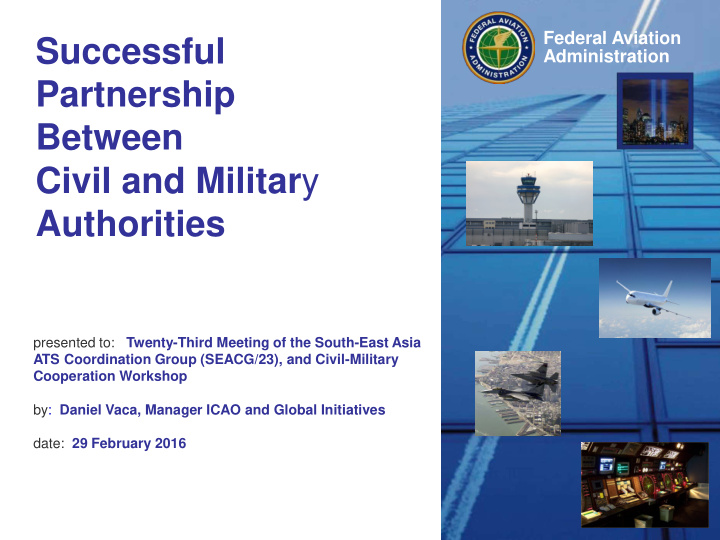



Federal Aviation Successful Administration Partnership Between Civil and Militar y Authorities presented to: Twenty-Third Meeting of the South-East Asia ATS Coordination Group (SEACG/23), and Civil-Military Cooperation Workshop by: Daniel Vaca, Manager ICAO and Global Initiatives date: 29 February 2016
Objectives Drawing from a long history of successful cooperation between the U.S. Federal Aviation Administration (FAA) and the U.S. military, this presentation will: • Highlight intersecting mission equities, infrastructure needs, and technology development trends. • Outline the mutual benefits of enhanced cooperation between Air Navigation Services Providers (ANSP) and their respective national militaries. • Point to key areas of shared complexity and promising ways forward through strengthened cooperation. Civil/Military Cooperation Federal Aviation 1 Administration ICAO Bangkok Regional Office
Engagement The FAA, particularly its ANSP component, the Air Traffic Organization (ATO), plays a critical role in supporting the U.S. military’s national defense mission 1 in terms of: Legal responsibilities and authorities, including the agency’s plenary authority over U.S. airspace, which was established to better enable the FAA to support air commerce (i.e., civil air traffic) and national defense . Operational capabilities, including Air Traffic Control (ATC) and shared systems such as long range radars. The success of the partnership between the FAA and the U.S. military, which intensified following 9/11, is built on respect and understanding for respective missions, collaboration, and earned trust. 1: This crucial support role also extends to domestic security, law enforcement, and emergency operations missions. Civil/Military Cooperation Federal Aviation 2 Administration ICAO Bangkok Regional Office
Trust as Foundation Identification of Shared Goals Quality Communication Continuous Constant Improvement Interaction TRUST Human Networking Transparent (Liaison/Exchange Sharing of Personnel) of Information Civil/Military Cooperation Federal Aviation 3 Administration ICAO Bangkok Regional Office
Intersections Key Characteristics mutual support shared resources interoperability ATM-centric trust-based partnership infrastructure military access national defense to airspace infrastructure Key Characteristics balanced access efficient utilization safe operations shared airspace heterogeneous traffic common procedures trust-based partnership civil access next generation ATM to airspace Key Characteristics future defense synchronized architecture systems leveraged scarce resources harmonized standards trust-based partnership Civil/Military Cooperation Federal Aviation 4 Administration ICAO Bangkok Regional Office
Linkages Agreements between the FAA and Department of Defense, including the North American Aerospace Defense Command (NORAD); and other key partners such as the Transportation Security Administration (TSA) and the Federal Emergency Management Agency (FEMA) International partnerships and links between the FAA and foreign Civil Aviation Authorities (CAA), ANSPs, and multilateral groups such as the International Civil Aviation Organization (ICAO) and EUROCONTROL Policy Planning Programs Procedures Tactical / Live Operations Linked Infrastructure through programs such Tactical coordination as the National Defense of air missions via the Program (NDP) Domestic Events Network (DEN) which Collaboration mechanisms between includes FAA air the FAA and the U.S. military (as well traffic facilities, DOD as other key stakeholders); linkage and other participants through the U.S. Department of Defense (DOD) Policy Board on Federal Aviation (PBFA) Liaisons; Both Air Traffic Representatives and Military Representatives Shared Procedures for Air Traffic Management (ATM) are present in each via FAA Order’s such as FAAO 7610.4M, Special Operations others facilities. Civil/Military Cooperation Federal Aviation 5 Administration ICAO Bangkok Regional Office
Productive Partnerships More efficient / optimized Leveraged scarce resources shared utilization of through shared / interoperable airspace systems (e.g., radars) Safer military operations Shared situational awareness interacting with civil flights Safer and more efficient Improved, more coherent ATM through common cooperation with other Industry procedures States on ATM and aviation related military Better mitigation of Operators matters impacts from incidents Military and security responses CAA & ANSP Synchronized development of future architecture (e.g., U.S. Faster identification of NextGen) anomalies posing potential threats Cooperation on transformational technologies Improved discrimination Creating a safe, efficient, between legitimate traffic and secure integrated Harmonization of key standards and genuine threats aviation system Civil/Military Cooperation Federal Aviation 6 Administration ICAO Bangkok Regional Office
Complexities The FAA constantly works with civil operators, the U.S. military, and other stakeholders balance competing demands for airspace access and air navigation services. Cooperative solutions : procedures and automation to improve the efficient use of special activity airspace used by the military. Military air missions must be integrated into civil air traffic in a way that supports effective defense efforts and safe and efficient civil aviation. Cooperative solutions : interagency coordination on Unmanned Aerial Systems (UAS), including case-by-case authorization of UAS. Civil/Military Cooperation Federal Aviation 7 Administration ICAO Bangkok Regional Office
Complexities The emergence of divergent technologies (e.g., Automatic Dependent Surveillance – Broadcast (ADS-B) are challenging established arrangements for the sharing of infrastructure, as well as the push for better shared situational awareness. Cooperative solutions : the integration of civil ATM focused and defense system needs through the NextGen program. Near and cross border defense and law enforcement operations are sometimes complicated by differing ATM and military procedures. Cooperative solutions : joint planning involving the neighboring military, law enforcement, CAA, and ANSP has yielded effective solutions (e.g., Vancouver 2010 Winter Olympics). Civil/Military Cooperation Federal Aviation 8 Administration ICAO Bangkok Regional Office
International Best Practices ICAO has been very successful in integrating safety concepts into standards and recommended practices, and procedures. Key Items in Building CIV/MIL Cooperation: Establish the necessary trust, common doctrine, and compatible technology. Coordinate both current operations and future planning within and across flight information boundaries. Develop the standards, procedures, and guidance material needed to facilitate sharing and common standards. Develop guidance material to promote global harmonization. Establish common understanding of roles and responsibilities. Develop Best Practices into requirements that can be incorporated into to ICAO Standards and Recommended Practices (SARP) and Procedures for Air Navigation Services (PANS). Civil/Military Cooperation Federal Aviation 9 Administration ICAO Bangkok Regional Office
Questions? Thank you! Civil/Military Cooperation Federal Aviation 10 Administration ICAO Bangkok Regional Office
Recommend
More recommend